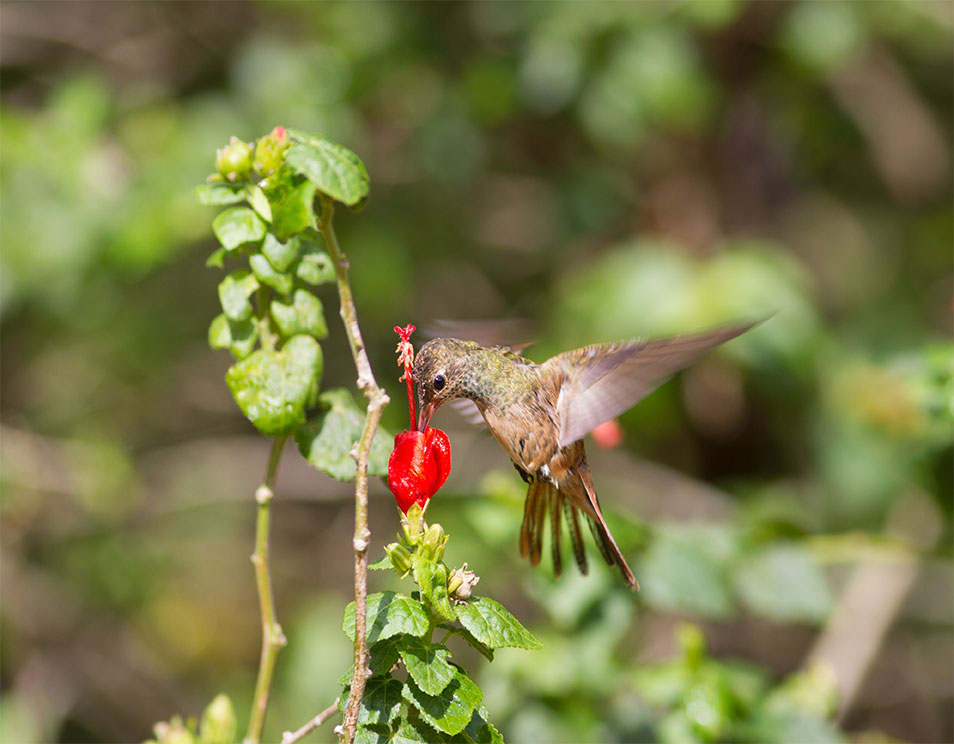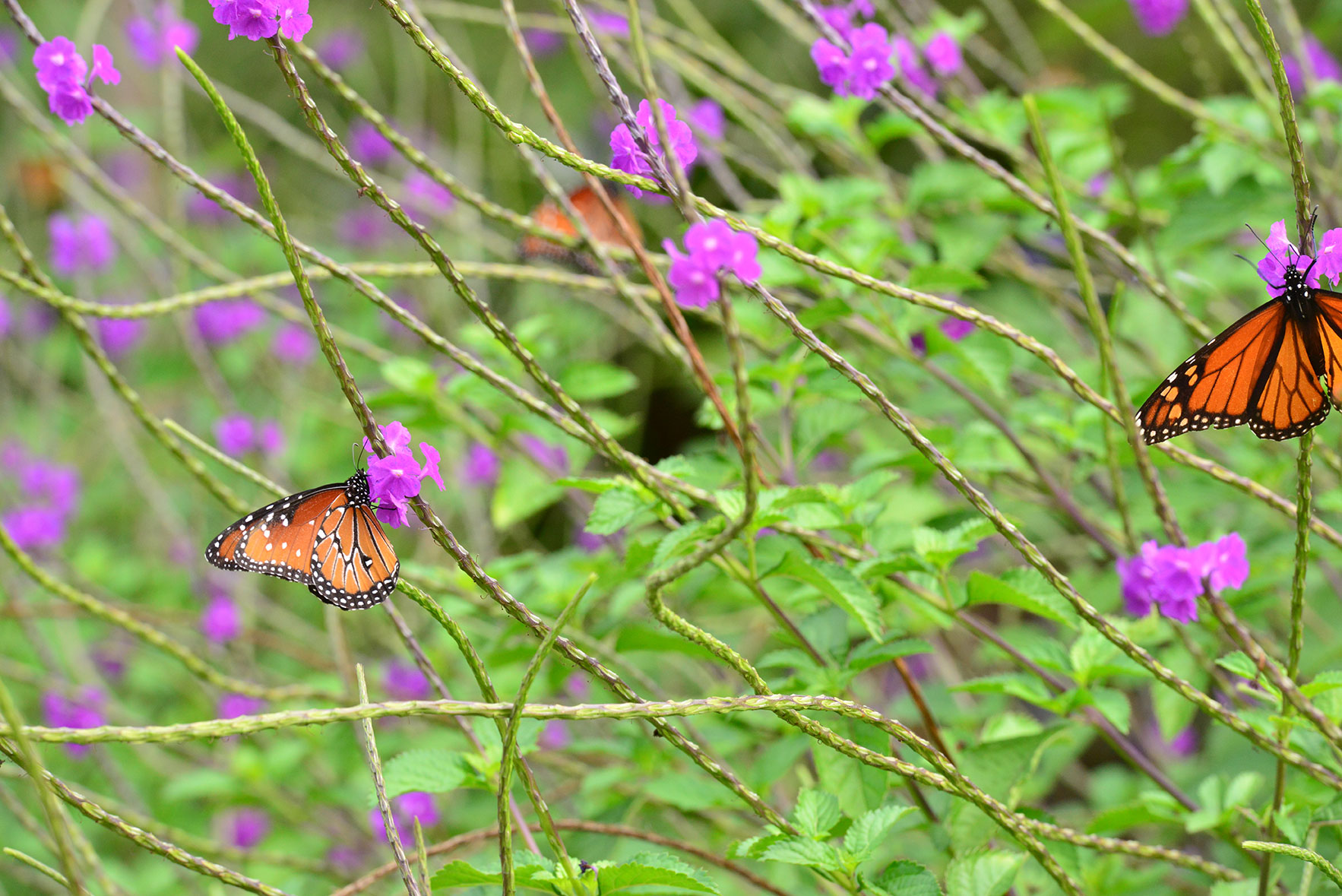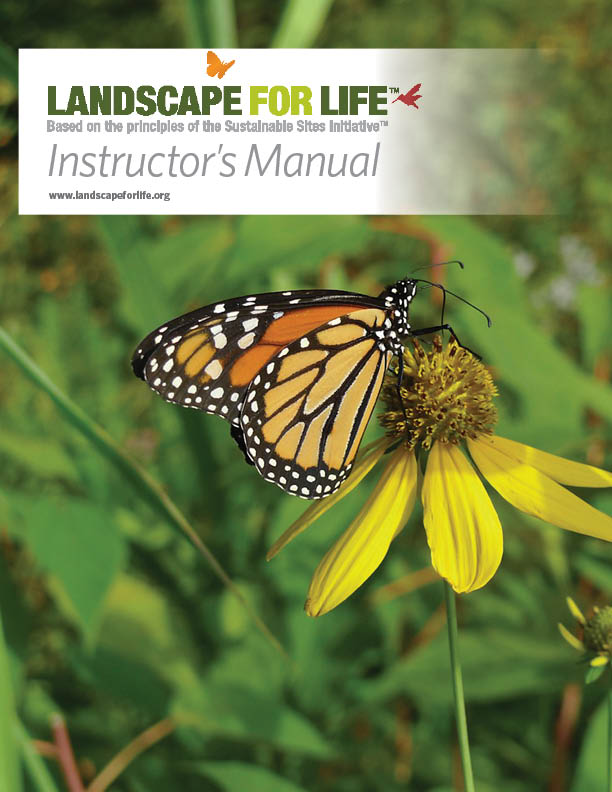WHY ARE POLLINATORS IMPORTANT?
It is estimated that about 90 percent of wild flowering plants depend on biotic pollination, such as that provided by bees, butterflies, wasps, moths, birds, bats and many other animals. Beyond that, approximately 100 different food crops produced in the United State depend primarily on biotic pollination; similarly, 25 percent of birds and some mammals also depend on the fruit and seed provided by flowering plants. Animal pollinators carry pollen on their bodies while traveling from one plant to another, a more efficient way for the plant to get fertilized (compared to wind pollination, where many pollen grains are lost in transit and do not make it to their intended destinations).

This buff-bellied hummingbird needs flowers like those on turkscap for nectar, and turkscap needs birds and insects for pollination. Image credit: Shutterstock/kenhartlein

A queen and monarch butterfly sipping nectar. Image credit: Shutterstock/Paul Briden
THE ROLE OF POLLINATORS IN A SUSTAINABLE GARDEN
Planting and growing a pollinator garden is a rewarding endeavor: It provides resources for the pollinators that visit and brings attractive and interesting wildlife for the gardener’s enjoyment. Natural habitat areas necessary to support pollinators have decreased significantly due to land development, prevalence of lawns and monoculture farm crops. Residential gardens and landscapes are critical to providing pollinators essential habitat, food, water, cover and places to raise their young. Pollinators rely on plants to provide them nutrients for their survival, while plants rely on pollinators to deliver pollen and ensure their long-term survival. Beyond providing a nutritious supply of fruits, vegetables and nuts to the world’s population, pollinators help maintain native plant communities, which provide a variety of other ecosystem services, such as:
- Carbon sequestration
- Water filtration
- Erosion control
- Soil health
- Urban heat island reduction
MORE ON POLLINATORS
According to a 2012 study by the United States Department of Agriculture Economic Research Service, residential areas in the United States are estimated to make up a total of 103 million acres of land. That’s an area of land equal to the entire state of California. While these landscapes provide an array of services for humans, pollinator species also use these landscapes for food, water and shelter; in doing so, they help maintain many functions necessary for the health of human habitats and our ecosystems at large. Without these insects and other animals, the vast majority of plants that provide food, clean our air and water, stabilize our soil, sequester carbon, and offer many other valuable ecosystem services could not survive.
Yet, there has been a significant population decline of pollinator species in the past three decades due largely to habitat loss and degradation. The primary stressors of this situation include the loss of breeding habitat due to agriculture and other land conversions, including both rural and urban developments, logging and deforestation at overwintering sites (particularly for monarch butterflies), pesticide and fertilizer use, and extreme weather conditions. Although we may not be directly associated with these stressors, we all are indirectly connected and thus must take responsibility and action to implement solutions.

A European honey bee pollinates a native purple coneflower. Image credit: Shutterstock/Jim and Lynne Weber
Unsustainable vs. Sustainable Gardens:
How They Compare
Unsustainable Gardens
- Plant diversity is minimal, and nonnative and ornamental invasive plant species are used in the garden.
- All soil is heavily covered with mulch or planted.
- Pools or dishes of drinking water are not provided.
- Thickets or hedges are frequently maintained as uniform shapes, requiring maintenance during pollinator activities, such as shelter or nesting.
- Lawns are large expanses of single grass species that are highly maintained, irrigated and fertilized.
- Entire lawn area is fertilized and chemically treated to remove weeds and other unwanted pests, which can be toxic to pollinators.
- New plants introduced to the garden have been grown in the nursery using neonicotinoids or other harmful pesticides, which are absorbed into plant tissue and can be present in pollen and nectar, making them toxic to pollinators.
Sustainable Gardens
- Diverse flowering native plant species and communities make up the garden.
- Among planted areas, bare soil is unaltered and left as nesting habitats or mud sources for pollinator species.
- Many intentional water sources are provided, such as birdbaths, ephemeral pools, shallow dishes and puddling places, and water is replenished regularly.
- Native plants grown in thickets or hedges act as windbreaks and/or nesting habitats and provide protection from predators; they are not cut back during pollinator activity.
- Lawns are reduced in size and diverse in plant species, including some flowering ground cover or forbs that are beneficial to pollinator species.
- Unwanted weeds and pests are removed by hand or other non-chemical procedures. Chemical spot treatment may occur but is infrequent and rare.
- New plants are purchased from nurseries that use less detrimental practices to treat plants during production.

BECOME A LANDSCAPE FOR LIFE TEACHER!
Expanded training opportunities coming in 2024! Landscape For Life includes a complete kit of teaching resources which can be used to conduct classes in sustainable home gardening.
Landscape For Life™ was developed by United States Botanic Garden and the Lady Bird Johnson Wildflower Center, based on the principles of the Sustainable Sites Initiative (SITES®). The program is now a collaboration between Colorado State University Extension and the United States Botanic Garden.




